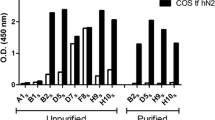Abstract
The formylpeptide receptor (FPR), previously found only on polymorphonuclear leukocytes and monocytes/macrophages, responds to both synthetic N-formyl oligopeptides and those produced by bacteria. The cDNA for human FPR has been cloned and a rabbit polyclonal antiserum directed against a synthetic 11-amino-acid peptide corresponding to the deduced carboxy-terminus has been produced. We have now extensively characterized and used the antibody to detect FPR on normal human tissues and cell types. The receptor antigen is present on some epithelial cells, especially those with a secretory function, and on some endocrine cells, e.g., follicular cells of the thyroid and cortical cells of the adrenal. Liver hepatocytes and Kupffer cells are positive. Smooth muscle and endothelial cells are also generally positive. In the brain and spinal cord, the neurons of the motor, sensory, and cerebellar systems, and those of the parasympathetic and sympathetic systems stain positively. These data suggest that the putative endogenous agonist for FPR or an antigenically similar receptor reacts with cellular targets in the neuromuscular, vascular, endocrine, and immune systems.
Similar content being viewed by others
Author information
Authors and Affiliations
Additional information
Received: 30 January 1997 / Accepted: 7 October 1997
Rights and permissions
About this article
Cite this article
Becker, E., Forouhar, F., Grunnet, M. et al. Broad immunocytochemical localization of the formylpeptide receptor in human organs, tissues, and cells. Cell Tissue Res 292, 129–135 (1998). https://doi.org/10.1007/s004410051042
Issue Date:
DOI: https://doi.org/10.1007/s004410051042




